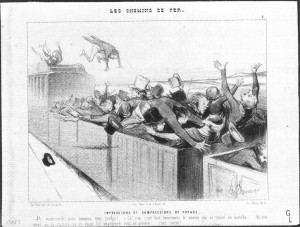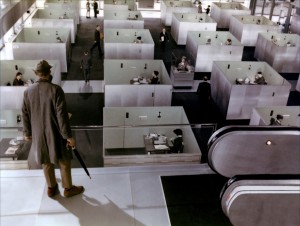Auteur : Eliza Culea_
[For the second part of this ongoing cyberculture article, we shall take a step back and look at the big picture. Before cyberspace and virtual worlds, society has already faced over two centuries of adaptation to another kind of man made creation, which for the sake of putting it simply we shall just name Technology. It is already an understatement to say it is a viable precedent in relation to our field of interest and therefore looking at the theories that try to define its relationship to society, offers valid glimpses also into understanding the cyberculture phenomenon. To begin with, we shall approach modernist theoretical perspectives [1], which tend to be shaped as incredibly self-sufficient, all-explaining and consistent entities of thought. Criticized for exactly those all-encompassing attributes by postmodern authors such as Jean-Francois Lyotard [2], who expressed wariness for their intent to offer universal truths, they are incredibly well constructed points of view and analysis of a given situation, that linger to this day in various forms as ways to understand and categorize the way we see the world. They have also had a decisive influence in all the fields of human creation including in the way we have shaped our cities, built our homes and structured our lives. Their characteristics, either strengths, legacies but also weaknesses, can be used as a start point for debating the attributes of cyberspace, in a larger context of historic precedents. There are largely four major categories that we shall approach, that can be further divided in two distinct parts: on one side ‘utopianism and futurism’ and ‘technological determinism’ which both view society and technology as separate entities with no interplay in between, and on the other hand ‘social constructivism’ and ‘political economy’ that offer a definite intertwined reading.]
Utopianism and futurism, child of the Age of Enlightenment, predicts that technology is the savior of the society from all its past, current and future ills. It contents itself to analyzing and documenting the revolutions that technology, and in this case cyberspace, is thought to bring upon the way we live. For utopians and futurists there are two ways technology can re-shape society. First of all, there is the reversionist approach which preaches a return to a society diffused in rural space and enamored with age-old handicraft and farming, but fully functional and viable due to a permanent inter-connection via cyberspace. Secondly there are descriptions of technophile lifestyles where urbanity is an increasingly emphasized and concentrated experience which is viewed as a continuously maturing condition. Although revisionist positions were frequent in the 19th century as a reaction to the ill effects of industrialization on the unprepared cities and further blossomed after WWII in the form of suburbias, it is the technophile urban interest that dominates the 20th century.
Utopian ideas have been around since being coined by Sir Thomas More in 1516, but technology related depictions of human settlements are slightly more recent and have a frequent opposite tone, describing a somewhat frightening or only partially attractive world – a dystopia. Set to have appeared in mass culture with the first anonymous publication of Mary Shelley’s Frankenstein in 1818, such tales regarding both the benefits and perils of the machine are most frequently set in minutely detailed cities, which become characters themselves. It suffices to quickly glance at Yevgeny Zamyatin We[3] and his fully artificial and orthogonal glass environment in which he made his main character D-503 feel both at peace and in sync but also undecidedly revolutionary, to see that the author shaped the city as a repository for all the vital traits of his dystopian society. We can also bring back into the spotlight the corporate driven Japanese inspired city that William Gibson penned in Neuromancer[4], but also throughout his entire work, which ended up a bigger part of popular imaginary than his plot lines.
Technological determinism argues that our lives are purely dictated by technology, which is an independent autonomous force, in a simple cause-and-effect relationship with society. In David Bells’ words[5], technology is done to society, to people, who are left simply to passively experience its effects, as adaptation as an only possible reaction. Technological change thus acquires an inevitable character, and determinists study exclusively ways in which society can adapt to present or future consequences, already viewed as certainties. Despite criticism that highlight that technologies are rarely neutral, abstract and purely independent, but influenced by an array of social, cultural, political and circumstantial factors, it is worth noting that D. Bell points out that this inevitability and lack of control is a wide-spread perception of the majority of the population with regards to technology.
These feelings of technological determinism have been recorded since the eve of the industrial revolution and show entire societies torn between both awe and anxiety, towards the new mechanical contraptions meant for public use such as the train. In the first chapter of her book Breaking frame: Technology and the Visual Arts in the Nineteenth Century, author Julie Wosk explores ‘the traumas of transport in the nineteenth century’[6] and shows that early travel accounts of unaccustomed passengers to train rides, frequently reported feelings of fear of being harmed (mangled, burned or mauled) by errant machines, and finding themselves in a total lack of control, leading American sociologist Erving Goffman to define these experiences as the phenomenon of ‘breaking frame’[7]. In the arts, it is Honoré Daumier’s[8] lithographs that are representative, depicting ‘the train as an inflexible technology, fixed in its own course, (…) indifferent to human needs[9]’. In cinema, Jacques Tati’s late Playtime once again casts the city in a main role, as an orthogonal, counter intuitive and human indifferent environment, in which poor Mr. Hulot, one of human characters – a country side man -, is desperately and unsuccessfully trying to figure the technological city out for the entire duration of the movie. Both Julie Wosk and Jacques Tati reveal in their work how technology can indeed make people feel as it is done to them, at least in its first waves of deployment.

Honoré DAUMIER, Impressions et Compressions de Voyage, dans les Chemins de Fer (1ére série), Le Charivari, 25 Juillet 1843
Social constructivism is in fact a direct critique to the strict separation used by previous categories, or a corrective to technological determinism[10], as it views technology and culture not only as intimately intertwined but furthermore, that technology is only a product of its social context. The shape of technological artifacts is considered the outcome of social processes that ‘stabilizes’ only once the relevant social groups that influence it have achieved an agreement. It focuses on a micro-scale analysis of the social processes that lead to this process of shaping and appropriation, and considers that its overall impact is created out of a sum of individual inputs, in a bottom-up endeavor. It also underplays the role of science and industry in the development of new technologies and takes for granted a certain cultural backgrounds that impact the types of interaction that can occur between the artifact and the individual.
In her book Internet Society: The Internet in Everyday Life, author Maria Bakardjieva[11] notes however that technology usually arrives to the user already ‘stabilized’ with uses and forms already fixed in a previous stage of development and refinement from which ordinary users are excluded. Furthermore, these artifacts do not encourage adaptation and exploration as they often present themselves as black box objects that have to be accepted in their given form, which constitutes essentially a technological determinist reading. However, she nuances her position by underlining that no matter how hard producers try to user-proof their products, an ‘irremediable ambiguity’ remains that inscribes particular uses and meanings that are beyond those initially intended for them. Thus the relationship between the user and technology is seen as a constant configuration and reconfiguration process, similar to the process of domesticating an animal[12], a process further detailed in fourth part of this article.
Political economy suggests that the relationship between society and technology is mediated by the capitalist modes of production and thus subjected to the political, economical and social relationships that define it, basing itself on the fact that technology is never neutral and usually developed in industrial or corporate interests. As opposed to the micro-scale look social constructivism uses, political economy focuses only on large scale political-economical structures, overplaying the role of capital and the numerous individual and institutional actions.
It sees technological development as a propagator for modernism as it reinforces hegemonic structures while allowing the improvement of living standards. The circulation of the myths of technology in popular culture, such as the rise of the creative class[13] and the information society in recent years, is considered only as a tool of developing the interests of those who initiate, manage and benefit from new technological revolutions such as governments, military establishments and transnational companies in a simple realignment to new opportunities and sources of capital [14]. In the specific case of the effects of cyberspace their main thesis is that we shall register a sharp decline in economical and a substantial increase in technological determinism as the internet becomes the ultimate site of both production and consumption.
***
These approaches that sit under the large umbrella of modernist approaches are still an active part of today’s discourse. They have been criticized for their quest of trying to create a grand unifying theory of society and knowledge leading to consistent independent entities, since in the end they prove to be mutually exclusive [15]. Even Graham and Marvin [16], the authors on whom this categorization is based, declare a preference for a crossed method involving moderate social constructivism tinted with some political economy theory. Faced with this predicament, postmodern theories, that will be sketched in Part 3 of this article, will cease searching universal for points of view and challenge the Enlightenment credo that scientific and technological progress leads to continuous economic development and prosperity.
Pour citer cet article
Eliza Culea, « Cyberculture Theory – Part 1: Origins and Science-Fiction », DNArchi, 14/11/2012, <http://dnarchi.fr/culture/cyberculture-theory-part-2-quick-guide-of-modernist-theoretical-approaches-on-technology/>
[1] This short introduction is based on the categories provided by: Steve Graham and Simon Marvin, Telecommunications and the City: Electronic Spaces, Urban places, London, Routledge, 1996 and overviewed by Rob Kitchin, Cyberspace. The World in the Wires, New-Jersey, Wiley-Blackwell, 1997.
[2] Jean-François Lyotard, The Postmodern Condition. A Report on Knowledge, Paris, Les Editions Minuit, 1979.
[3] Yevgeny Zamyatin, We, New York, Dutton, 1924, (1921).
[4] William Gibson, Neuromancer, New York, Ace Books, 1984.
[5] David Bells, Cyberculture Theorists: Manuel Castells and Donna Haraway, New York, Routledge, 2009.
[6] Julie Wosk, Breaking frame: Technology and the Visual Arts in the Nineteenth Century, New Jersey: Rutgers University Press, 1992, p.30.
[7] ‘the experience of breaking frame occurs when the basic frameworks of understanding used to make sense out of events no longer apply‘, in Wosk, op. cit., p.3.
[8] Dominant European caricaturist of the 19th century.
[9] Wosk, Op. cit., p.59.
[10] David Bell, Cyberculture Theorists, Op.cit., p.8.
[11] Maria Bakardjieva, Internet Society: The Internet in Everyday Life, London, Sage, 2005.
[12] Donna Haraway, When Species Meet, Minneapolis: University of Minnesota Press, 2007.
[13] term coined by economist and social scientist Richard Florida in his works such as: The Rise of the Creative Class, New York, Basic Books, 2002. R. Florida defines it as knowledge-based workforce class representing roughly 30% of the US active citizens in various domains, which draw on their body of expertise (higher education diplomas or extensive experience) in order to creatively solve given problems.
[14] Arthur Kroker, Michael A. Weinstein, Data Trash: The Theory of the Virtual Class, Montreal, New World Perspectives, 1994.
[15] Michael Dear, ‘The Postmodern Challenge: reconstructing human geography’ in Transactions of the Institute of British Geographers, no. 13, 1988, p.262-274.
[16] Graham and Marvin, Telecommunications and the City, Op.cit.



